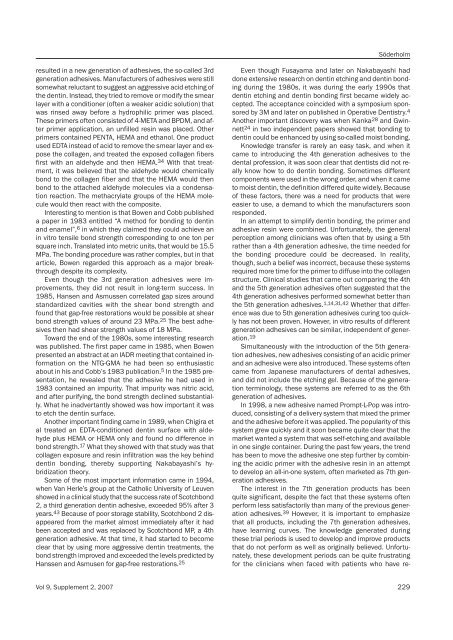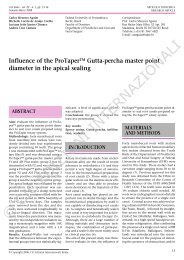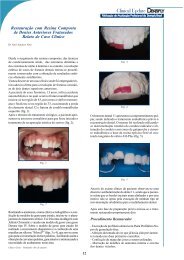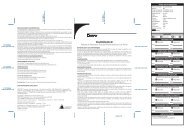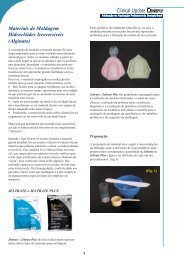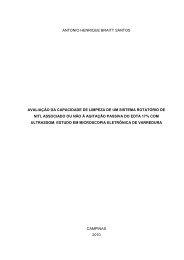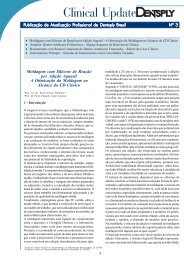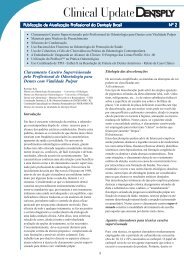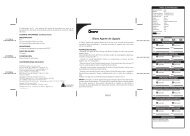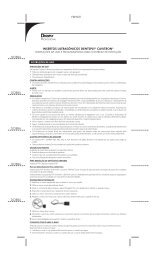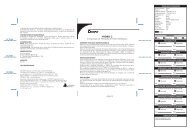Create successful ePaper yourself
Turn your PDF publications into a flip-book with our unique Google optimized e-Paper software.
Söderholm<br />
resulted in a new generation of adhesives, the so-called 3rd<br />
generation adhesives. Manufacturers of adhesives were still<br />
somewhat reluctant to suggest an aggressive acid etching of<br />
the dentin. Instead, they tried to remove or modify the smear<br />
layer with a conditioner (often a weaker acidic solution) that<br />
was rinsed away before a hydrophilic primer was placed.<br />
These primers often consisted of 4-META and BPDM, and after<br />
primer application, an unfilled resin was placed. Other<br />
primers contained PENTA, HEMA and ethanol. One product<br />
used EDTA instead of acid to remove the smear layer and expose<br />
the collagen, and treated the exposed collagen fibers<br />
first with an aldehyde and then HEMA. 34 With that treatment,<br />
it was believed that the aldehyde would chemically<br />
bond to the collagen fiber and that the HEMA would then<br />
bond to the attached aldehyde molecules via a condensation<br />
reaction. The methacrylate groups of the HEMA molecule<br />
would then react with the composite.<br />
Interesting to mention is that Bowen and Cobb published<br />
a paper in 1983 entitled “A method for bonding to dentin<br />
and enamel”, 6 in which they claimed they could achieve an<br />
in vitro tensile bond strength corresponding to one ton per<br />
square inch. Translated into metric units, that would be 15.5<br />
MPa. The bonding procedure was rather complex, but in that<br />
article, Bowen regarded this approach as a major breakthrough<br />
despite its complexity.<br />
Even though the 3rd generation adhesives were improvements,<br />
they did not result in long-term success. In<br />
1985, Hansen and Asmussen correlated gap sizes around<br />
standardized cavities with the shear bond strength and<br />
found that gap-free restorations would be possible at shear<br />
bond strength values of around 23 MPa. 25 The best adhesives<br />
then had shear strength values of 18 MPa.<br />
Toward the end of the 1980s, some interesting research<br />
was published. The first paper came in 1985, when Bowen<br />
presented an abstract at an IADR meeting that contained information<br />
on the NTG-GMA he had been so enthusiastic<br />
about in his and Cobb’s 1983 publication. 5 In the 1985 presentation,<br />
he revealed that the adhesive he had used in<br />
1983 contained an impurity. That impurity was nitric acid,<br />
and after purifying, the bond strength declined substantially.<br />
What he inadvertantly showed was how important it was<br />
to etch the dentin surface.<br />
Another important finding came in 1989, when Chigira et<br />
al treated an EDTA-conditioned dentin surface with aldehyde<br />
plus HEMA or HEMA only and found no difference in<br />
bond strength. 17 What they showed with that study was that<br />
collagen exposure and resin infiltration was the key behind<br />
dentin bonding, thereby supporting Nakabayashi’s hybridization<br />
theory.<br />
Some of the most important information came in 1994,<br />
when Van Herle’s group at the Catholic University of Leuven<br />
showed in a clinical study that the success rate of Scotchbond<br />
2, a third generation dentin adhesive, exceeded 95% after 3<br />
years. 43 Because of poor storage stability, Scotchbond 2 disappeared<br />
from the market almost immediately after it had<br />
been accepted and was replaced by Scotchbond MP, a 4th<br />
generation adhesive. At that time, it had started to become<br />
clear that by using more aggressive dentin treatments, the<br />
bond strength improved and exceeded the levels predicted by<br />
Hanssen and Asmusen for gap-free restorations. 25<br />
Even though Fusayama and later on Nakabayashi had<br />
done extensive research on dentin etching and dentin bonding<br />
during the 1980s, it was during the early 1990s that<br />
dentin etching and dentin bonding first became widely accepted.<br />
The acceptance coincided with a symposium sponsored<br />
by 3M and later on published in Operative Dentistry. 4<br />
Another important discovery was when Kanka 28 and Gwinnett<br />
24 in two independent papers showed that bonding to<br />
dentin could be enhanced by using so-called moist bonding.<br />
Knowledge transfer is rarely an easy task, and when it<br />
came to introducing the 4th generation adhesives to the<br />
dental profession, it was soon clear that dentists did not really<br />
know how to do dentin bonding. Sometimes different<br />
components were used in the wrong order, and when it came<br />
to moist dentin, the definition differed quite widely. Because<br />
of these factors, there was a need for products that were<br />
easier to use, a demand to which the manufacturers soon<br />
responded.<br />
In an attempt to simplify dentin bonding, the primer and<br />
adhesive resin were combined. Unfortunately, the general<br />
perception among clinicians was often that by using a 5th<br />
rather than a 4th generation adhesive, the time needed for<br />
the bonding procedure could be decreased. In reality,<br />
though, such a belief was incorrect, because these systems<br />
required more time for the primer to diffuse into the collagen<br />
structure. Clinical studies that came out comparing the 4th<br />
and the 5th generation adhesives often suggested that the<br />
4th generation adhesives performed somewhat better than<br />
the 5th generation adhesives. 1,14,31,42 Whether that difference<br />
was due to 5th generation adhesives curing too quickly<br />
has not been proven. However, in vitro results of different<br />
generation adhesives can be similar, independent of generation.<br />
19<br />
Simultaneously with the introduction of the 5th generation<br />
adhesives, new adhesives consisting of an acidic primer<br />
and an adhesive were also introduced. These systems often<br />
came from Japanese manufacturers of dental adhesives,<br />
and did not include the etching gel. Because of the generation<br />
terminology, these systems are referred to as the 6th<br />
generation of adhesives.<br />
In 1998, a new adhesive named Prompt-L-Pop was introduced,<br />
consisting of a delivery system that mixed the primer<br />
and the adhesive before it was applied. The popularity of this<br />
system grew quickly and it soon became quite clear that the<br />
market wanted a system that was self-etching and available<br />
in one single container. During the past few years, the trend<br />
has been to move the adhesive one step further by combining<br />
the acidic primer with the adhesive resin in an attempt<br />
to develop an all-in-one system, often marketed as 7th generation<br />
adhesives.<br />
The interest in the 7th generation products has been<br />
quite significant, despite the fact that these systems often<br />
perform less satisfactorily than many of the previous generation<br />
adhesives. 39 However, it is important to emphasize<br />
that all products, including the 7th generation adhesives,<br />
have learning curves. The knowledge generated during<br />
these trial periods is used to develop and improve products<br />
that do not perform as well as originally believed. Unfortunately,<br />
these development periods can be quite frustrating<br />
for the clinicians when faced with patients who have re-<br />
Vol 9, Supplement 2, 2007 229


